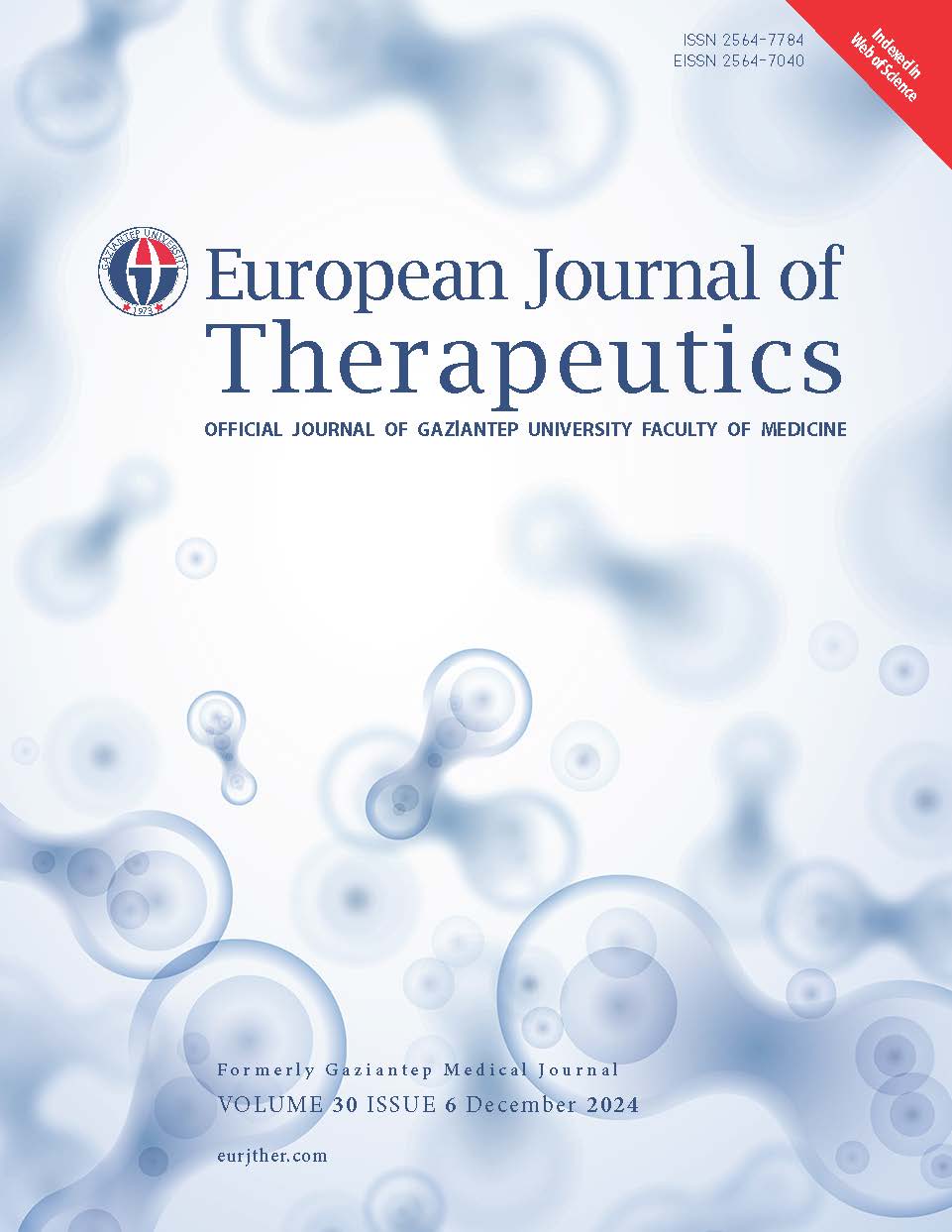Recurrence and Factors Associated with Recurrence in Dupuytren's Disease Patients Treated with Percutaneous Needle Aponeurotomy
DOI:
https://doi.org/10.58600/eurjther2500Keywords:
Dupuytren, percutaneous needle aponeurotomy, recurrenceAbstract
Objective: Dupuytren's disease (DD) is a progressive condition of the palmar fascia that limits finger extension. Percutaneous needle aponeurotomy has become increasingly popular in recent years. Despite appropriate treatment, recurrence is common. This study investigates recurrence development following percutaneous needle aponeurotomy and evaluates the relationship between patient characteristics, disease-related factors, and recurrence in DD.
Methods: This retrospective study included 98 fingers from 41 patients diagnosed with Dupuytren's disease who underwent percutaneous needle aponeurotomy at a hand surgery outpatient clinic between 2012 and 2022. Patient records were reviewed, and characteristics such as age, gender, occupation, and dominant hand were documented. The stage of DD was determined preoperatively. Functional outcomes were assessed using a subjective satisfaction scale, and postoperative complications and recurrences were analyzed.
Results: Of the 41 patients, 32 (78%) were male and 9 (22%) were female. The mean age was 62 years (range, 44–82 years), and the mean follow-up period was 45 months (range, 9–138 months). Postoperative evaluations showed that 17 patients (41.5%) had excellent results, 19 patients (46.3%) had good results, and 5 patients (12.2%) had fair results. Recurrence of Dupuytren's disease occurred in 24 (58.5%) patients. Among all patients, 30 (73.2%) were willing to undergo reoperation, regardless of recurrence. The recurrence rate was significantly lower after percutaneous needle release in stage 1 DD (p = 0.011).
Conclusion: Percutaneous needle aponeurotomy offers high patient satisfaction and early discharge benefits, making it a preferred option for surgeons, despite the potential for recurrence. While the classification of recurrence as a complication is debated, it is a recognized outcome of progressive DD. Regardless of patient characteristics, performing percutaneous needle aponeurotomy at an early stage can significantly reduce recurrence rates.
Metrics
References
. Dutta A, Jayasinghe G, Deore S, et al. Dupuytren’s Contracture - Current Concepts. J Clin Orthop trauma. 2020;11(4):590-596. https://doi.org/10.1016/J.JCOT.2020.03.026
. Aissvarya S, Ling KH, Arumugam M, Thilakavathy K. Molecular genetics of Dupuytren’s contracture. EFORT open Rev. 2024;9(8):723-732. https://doi.org/10.1530/EOR-23-0056
. Almadani YH, Vorstenbosch J, Efanov JI, Xu L. Dupuytren’s Disease: An Outcomes-Focused Update. Semin Plast Surg. 2021;35(3):216-222 https://doi.org/10.1055/S-0041-1731631
. Boe C, Blazar P, Iannuzzi N. Dupuytren Contractures: An Update of Recent Literature. J Hand Surg Am. 2021;46(10):896-906. https://doi.org/10.1016/J.JHSA.2021.07.005
. Yeo JH, Kim JY. Minimally Invasive Treatments of Dupuytren Disease: An Overview. J hand Surg Asian-Pacific Vol. 2021;26(2):131-141. https://doi.org/10.1142/S2424835521400026
. Karakaplan M, Ertem K, Polat H, Sakçi MŞ, Oklu Y. Percutaneous needle aponeurotomy for the treatment of Dupuytren’s contracture. EklemHastalikCerrahisi. 2019;30(1):53-60. https://doi.org/10.5606/EHC.2019.58854
. Tubiana R, Michon J, Thomine JM. Scheme for the assessment of deformities in Dupuytren's disease. Surg Clin North Am. 1968;48(5):979-984. https://doi.org/10.1016/s0039-6109(16)38630-
. Radhamony NG, Nair RR, Sreenivasan S, Walkay S, Soni A, Kakkar R. Residual deformity versus recurrence following Dupuytren’s palmar fasciectomy-a long term follow-up of 142 cases. Ann Med Surg. 2022;73. https://doi.org/10.1016/J.AMSU.2021.103224
. Moog P, Buchner L, Cerny MK, Schmauss D, Megerle K, Erne H. Analysis of recurrence and complications after percutaneous needle fasciotomy in Dupuytren’s disease. Arch Orthop Trauma Surg. 2019;139(10):1471-1477. https://doi.org/10.1007/S00402-019-03247-Y
. Toppi JT, Trompf L, Smoll NR, et al. Dupuytren’s contracture: an analysis of outcomes of percutaneous needle fasciotomy versus open fasciectomy. ANZ J Surg. 2015;85(9):639-643. https://doi.org/10.1111/ANS.12513
. van Rijssen AL, Gerbrandy FSJ, Linden H Ter, Klip H, Werker PMN. A comparison of the direct outcomes of percutaneous needle fasciotomy and limited fasciectomy for Dupuytren’s disease: a 6-week follow-up study. J Hand Surg Am. 2006;31(5):717-725. https://doi.org/10.1016/J.JHSA.2006.02.021
. Nichlos E, Wölfle O, Marzi I, Frank J, Sommer K. [Medium-term Results after percutaneous Needle Fasciotomy in Dupuytren’s Disease]. HandchirMikrochirPlastChir. 2023;55(5):330-335. https://doi.org/10.1055/A-2055-1592
. Duygun F, Aldemir C. The frequency of De Quarvain Tenosynovitis, Trigger Finger and Dupuytren Contracture accompanying Idiopathic Carpal Tunnel Syndrome. Med Sci | Int Med J. 2017;6(4):1. https://doi.org/10.5455/MEDSCIENCE.2017.06.8678
. Kang Y, Stewart M, Patel M, Furniss D, Wiberg A. Modifiable Risk Factors for Prevention in Dupuytren Disease: A UK Biobank Case-Control Study. PlastReconstr Surg. 2024;153(2):363E-372E. https://doi.org/10.1097/PRS.0000000000010774
. Haines A, Levis C, Goldsmith CH, et al. Dupuytren’s contracture and handwork: A case-control study. Am J Ind Med. 2017;60(8):724-733. https://doi.org/10.1002/AJIM.22736
. Mohede DCJ, Riesmeijer SA, De Jong IJ, Werker PMN, Van Driel MF. Prevalence of Peyronie and Ledderhose Diseases in a Series of 730 Patients with Dupuytren Disease. PlastReconstr Surg. 2020;145(4):978-984. https://doi.org/10.1097/PRS.0000000000006642
. Hindocha S, Stanley JK, Watson S, Bayat A. Dupuytren’s diathesis revisited: Evaluation of prognostic indicators for risk of disease recurrence. J Hand Surg Am. 2006;31(10):1626-1634. https://doi.org/10.1016/J.JHSA.2006.09.006
. Jurisić D, Ković I, Lulić I, Stanec Z, Kapović M, Uravić M. Dupuytren's disease characteristics in Primorsko-goranska County, Croatia. Coll Antropol. 2008 Dec;32(4):1209-13. PMID: 19149230.
Downloads
Published
How to Cite
Issue
Section
License
Copyright (c) 2024 European Journal of Therapeutics

This work is licensed under a Creative Commons Attribution-NonCommercial 4.0 International License.
The content of this journal is licensed under a Creative Commons Attribution-NonCommercial 4.0 International License.


















